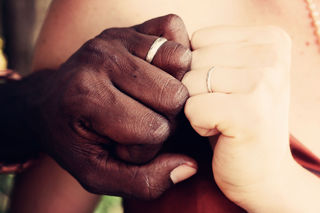Relationships
Prejudice Toward Relationships
Prejudice targets not only individuals, but relationships, too.
Posted March 27, 2017

I enjoy looking at aspects of life in a holistic, broad way, to the best of my ability. Without question, I have plenty of blind spots because, well, I’m human and we all do. But I relish the never-ending journey of trying to question unchecked assumptions and make out what I didn’t spot before. And a big picture outlook on romantic relationships helps us to recognize that they don’t exist in a bubble. They live in a multilayered social and cultural context that touches and affects them. For that reason, when we explore relationships in this blog, sometimes we’ll zoom into the dynamics between two people, and other times we’ll pan out and consider the larger habitat that relationships thrive, survive, and die in. This post is dedicated to one piece of that wider backdrop: Social bias and prejudice toward relationships.
Many of us tend to think of prejudice as a negative stance toward individuals because of some quality they possess or a group they belong to, such as their gender, race, sexual orientation, age, socioeconomic status, or religious affiliation, to name just a few. But relationships can face prejudice too, as society also passes judgment on couples whose pairing falls outside the lines of what it defines as customary and appropriate. Exemplars of such unions that have received attention in relationship science include same-sex couples, interracial relationships, and unions with a notable age difference (defined as more than 10 years). At one level, this may seem a bit far-fetched and outdated. Marriage equality for same-sex couples is the law of the land and now the majority of people are in favor of it. Most folks don’t appear to bat an eye at the idea of people dating and marrying across racial lines. And we see plenty of examples of couples with distinct age gaps in popular culture. No big deal, right? Why are we even thinking about this?
Let me be clear. I’m not trying to say that social attitudes toward couples who go against the grain haven’t dramatically progressed—they have. A mere 50 years ago, interracial marriage wasn’t even legal throughout the United States, and it took the 1967 Supreme Court case of Loving vs. Virginia to change that. Then fast forward to 2013, and we see a Gallup poll showing that 87% of the country approves of interracial marriage. And just 13 years ago, same-sex marriage wasn’t legal anywhere in the United States. Unquestionably, society has marched forward in its attitudes toward relationships. But does this mean that relationships that don’t quite fit the conventional mold of opposite-sex, matched-age, monoracial couples don’t endure prejudice and discrimination compared to more typical unions? Absolutely not. Such couples are still more apt to face unfavorable attitudes, to feel less accepted, and to experience dismissive or demeaning treatment. Prejudice toward these relationships exists; it’s just gone a little more underground than it was in the past. Here we’ll take a closer look at each of these three relationships. Of course, there are couples who fit more than one of these categories, but in the interest of clarity and attention to each type of relationship here, we’ll focus on them separately.
Interracial Relationships
First, consider the 87% interracial marriage approval statistic we just saw. On the surface, this number seems to tell us that nearly everyone is wholeheartedly in favor of it. But do these poll results truly reflect a virtually universal embrace of interracial romantic relationships and marriage? Unfortunately, when we dig a little deeper, the answer seems to be no. When you ask people about how they feel about interracial marriage, the answer you get depends on how you frame the question. Sure, 87% of people say they’re in favor of it in principle. But what about when it comes to a family member marrying interracially? According to a 2010 survey, only 66% are comfortable with it. And among college students, although those who date interracially are apt to improve their attitudes toward other racial groups by the end of their college years, they’re also more likely to feel a greater sense of pressure from people they know to date within their own race. In other words, most people approve of interracial dating and marriage, but not quite as many do when it’s in their own backyard.
On top of the social pressure that people may encounter to date members of their own race, according to a 2009 study of internet daters, a personal preference to date within one’s own racial group strongly remains. And although the percentage of people who interracially marry is increasing, only 12% of all new marriages in 2013 were interracial. So even though we’ve come quite far in our willingness to cross racial lines in marriage and dating, as a whole most of us still marry and date in pretty racially segregated ways.
And among couples who do cross racial lines, they face challenges that monoracial couples generally do not have to consider. One study found that interracial couples are less inclined to show physical affection toward each other in public compared to same-race couples. Interracial relationships are also linked to concerns such as:
- Fears of how friends and family members will react
- Rejection from loved ones
- Public stares
- Resentment of other people for dating outside one’s own race or for diminishing another racial group’s dating pool
- Fear that a person of another race may be too culturally incompatible
Moreover, interracial couples experience poorer physical health than monoracial couples. This is consistent with other research showing that people in relationships that do not feel socially validated or supported are at greater risk for health problems, worsened mood, and low self-esteem.
Same-Sex Relationships
True, most people support same-sex marriage, but most just means over half, which is unfortunately accurate when it comes to current approval numbers. Only 55% percent of people support same-sex marriage. If we consider this statistic from the viewpoint of the progress we’ve made as a society, then it probably feels like a big number. But when we think about the daily lived experiences of same sex-couples, this means that almost half of their fellow citizens see their relationship as invalid and unfit for marriage. What’s more, almost 40% of people see same-sex relationships as not only ineligible for marriage, but immoral. From that vantage point, 55% approval feels far too small.
Unlike many heterosexual couples, same-sex couples face the stereotype that they can’t cultivate a deeply emotionally connected, ever-lasting union. They also have to contend with the dilemma of whether to reveal their relationship to family members, friends, and colleagues, risking censure and disapproval, or hold on to acceptance and keep their bond a secret. And in the midst of a culture that tells you that who you love is not “normal,” which lesbian, gay, and bisexual individuals frequently deal with, it can be hard to resist soaking up that attitude over time and directing it inward toward yourself, a phenomenon known as internalized homophobia. This kind of inner stigma as well as the prejudice from others that same-sex couples must go up against are connected to greater problems within the relationship. Internalized homophobia can also present an agonizing conflict for some, as the person who they dearly love is also a reminder of what they’re ashamed of. Yet even for people who are burdened with this kind of self-reproach, if they don’t believe they’ll encounter prejudice in their own social world, they’re more apt to take an optimistic view of their relationship. And when it comes to having children, even though the road has become much smoother for same-sex couples who want to adopt, it remains bumpier than it is for opposite sex-couples. For example, you could take the greatest, most loving would-be parents ever who are yearning to adopt, but if they live in the state of Mississippi, they’re still not allowed to do so.
Age-Gap Couples
According to a 2013 U.S. Census Bureau survey, 90% of all heterosexual married couples in the United States involve a husband and a wife who are no more than nine years apart in age; in almost 77% of marriages, there’s no more than a five-year age difference. These numbers also map onto the age difference that people say they’re looking for in a partner, with men and women generally partial to a three-year age gap. Among those who love and marry across a wider age divide, they can encounter social difficulties that more similarly aged couples do not. Notably, they face widespread skepticism and stereotypes. Common examples include the notions that relationships with notable age gaps simply can’t go the distance, and that the couple must be too different to find common ground and thrive together. Other popular ideas are that the person who is younger must have a financial motive, or that the younger partner desires the relationship in a misguided attempt to resolve parental issues. In light of these notions, it’s probably not surprising that age-gap relationships face pervasive social condemnation, and the partners are all too aware of it. Across interracial, same-sex, and age-gap relationships, we know the least about the latter, as very little research has attended to these couples. But what we can say is that relationship science doesn’t support the myths that age-gap relationships reflect unfinished parental issues or are less happy than age-matched unions.
Where Do We Go from Here?
Most of what we know about prejudice centers around individuals. So we have much to understand when it comes to how, when, and why prejudice and discrimination target and impact relationships. We do know from relationship science that how we feel about ourselves has an impact on our relationship with our partner. When we see ourselves in a positive light, it makes it easier for us to let someone else in and accept their love and affection. So as we strive to elevate our sense of self-esteem, we make a potent investment in our relationship and offer it some protection in the face of prejudice and discrimination. But according to many researchers, when the strain of social prejudice and discrimination weighs down, it can seep inside and tear down how people feel about themselves.
And here we come full circle, back to our social environment and the fact that relationships don’t live in a bubble. The social web that couples face can have an impact on their sense of self and their relationship. For instance, for people who are members of racial or sexual minority groups, discrimination is linked to lower self-esteem and diminished relationship wellness. And among interracial and same-sex couples, social disapproval of their relationship is linked to lower devotion and confidence, among other problems. Although couples who believe in social equality and handle stress well together can insulate themselves from this a bit, they still have to contend with social obstacles that could hamper their bond, obstacles that many other couples do not have to consider.
True, it’s not possible to socially insulate couples from everyone who holds prejudiced views against their relationship. But to the extent that we as individuals and as a society can question negative stereotypes about diverse couples and extend more positive and supportive messages to them, we can start to turn the social tide they swim into. The media can also be a potent helper here. For instance, positive media portrayals of interracial relationships are connected to improved, more favorable mindsets toward interracial couples. Arguably, more favorable, recurring media depictions of same-sex and age-gap couples would also serve to enhance attitudes toward these relationships as well. And thankfully, if we’re in a relationship that falls outside of traditional bounds, we can choose to seek out and cultivate social networks that approve of and support our union.
Of course, we’ve just scratched the surface of what I believe is a vital topic. If you’re in a relationship like the ones we’ve explored, I wish you every happiness as you move forward with your partner, and hope this post offered a bit of recognition and validation. Perhaps you’re not in such a relationship, but are having a hard time supporting one. In that case, I’d like to invite you to open the door to exploring whether there may be just a little room to move toward greater acceptance.
Thank you for reading.




